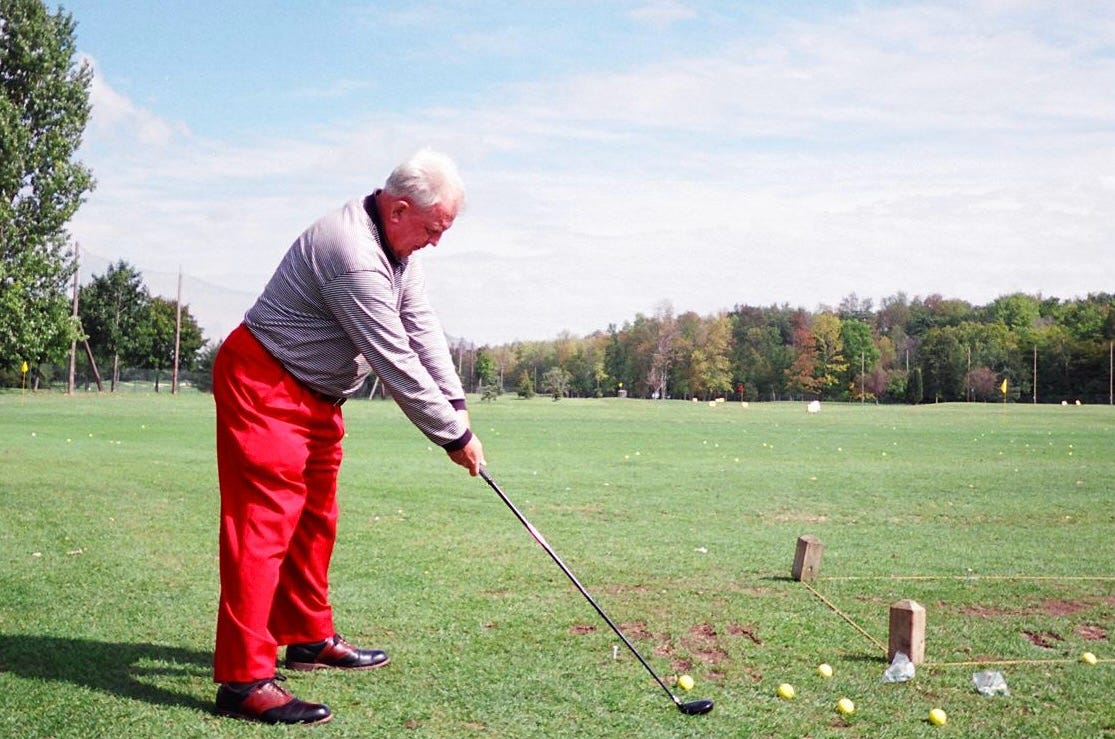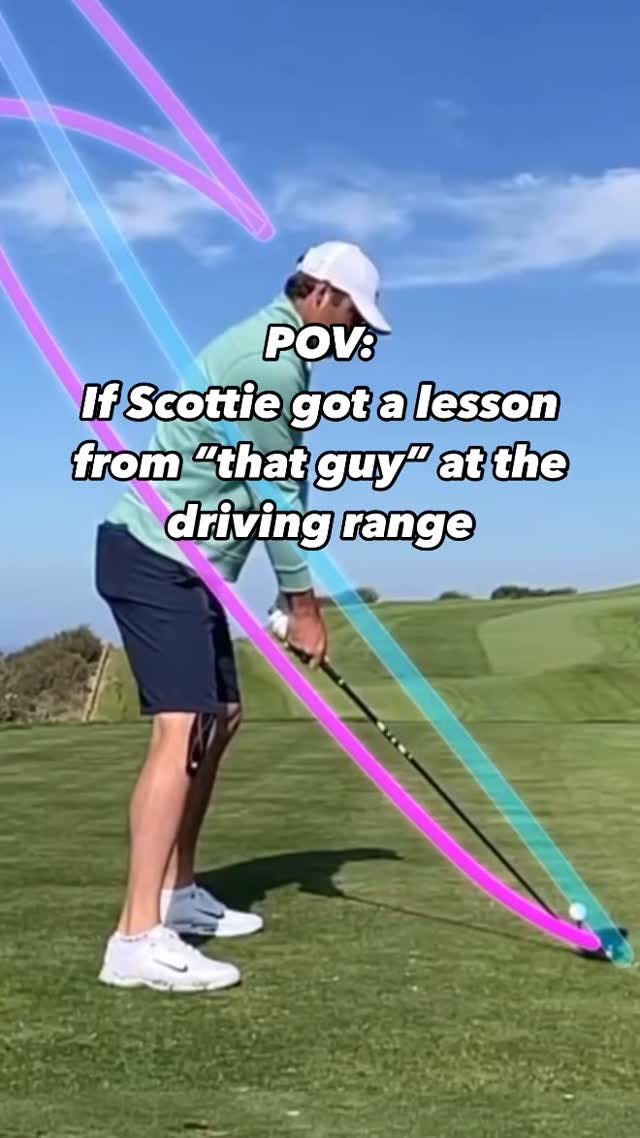Scottie and Moe: not ‘the’ way, but their way
Contrary to belief, feeling good is more important than a good-looking swing

Scottie is the golfer of the moment, but he doesn’t comfortably fit everyone’s idea of a No. 1 golfer.
His family-and-faith-first narrative makes a lot of people twitchy. He’s toned down the God talk but many folks still bristle and sneer—as happens to folks unapologetically open about their faith—that he’s stuffing God done our gullets. I don’t think he gives a tinker’s damn if you’re into God.
The reaction to his comments before the Open Championship that golf didn’t fulfil him was typical how he doesn’t fit the neat and tidy story of someone making their major dreams come true.
As Scheffler was heading toward his coronation, Dan Hicks and Kevin Kisner did their TV best to build some drama into the forgone conclusion by referring to Scheffler’s comments, but they didn’t venture into the not-fulfilled bit. Instead, they focused on the familiar and digestible story lines about his commitment to golf and to his family.
To say ascending to the summit of Mount Golf didn’t fulfil Scheffler would have siphoned off some of the emotional attachment that TV types try to manufacture to keep us watching.
And what about that swing? There’s lots to admire about the way he lashes with abandon through a ball, balance be damned, but it has none of Adam Scott’s aesthetic purity or Tiger’s or Rory’s balance of power and grace. It sure doesn’t match what any online guru is preaching, and thus his swing can’t be leveraged to make money. In fact, he appears to contradict a lot of the sacred cows of golf instruction.
Like Bubba Watson’s swing, Scottie’s is a mystery to behold. Even in slo mo, it’s difficult to say he gets X because he does Y. It’s a uniquely personal swing which he completely owns and which he developed largely on his own.
Randy Smith, his coach since Scheffler was eight, says he didn’t impose any kind of models or positions on him, but guided him to make his own discoveries.
Smith told Golf Digest that Scheffler became a monster golfer due to his extraordinary competitiveness and his “pure love of practicing and experimenting and learning things on your own.”
The idea of a self-coaching golfer exploring their own experiences runs counter to a golf culture that preaches there are right and wrong ways to swing a golf club.
There are coaches who advocate developing your own swing, but they’re not superstar gurus or influencers.
A coach who works with PGA Tour players told me that golfers want to be told what they’re doing wrong and how to fix it. This approach doesn’t help most people improve, but it’s a great business model.
There’s a history of winning players whose swings were regarded as weird because they didn’t fit perceptions of perfect form, including Bruce Lietzke, Lee Trevino, Moe Norman, Colin Montgomerie and Jim Furyk, whose swing was described by David Feherty as resembling an “octopus falling out of a tree.”
I recall TV analyst Judy Rankin, a former LPGA Tour star, admiring Brooke Henderson’s ball-striking while adding “it’s not a swing you would teach.”
While the late Moe Norman never became a tour star—among other reasons, his personality wasn’t suited for tour life—he is regarded as one of the best ball-strikers in history. For most of his career, Moe’s swing mystified folks because—like Scheffler’s—it contravened hallowed tenets of the swing with this wide stance, straight legs and arms at address, and right-hand palm grip.
When Moe was developing his swing in his late teens, he was often told that “no one swings like that.” In fact, people ridiculed him.
“It suited me and felt good. I’m a different kind of golfer. Every day it felt better and better. Everyone said it was wrong,” Moe told me when he was 65.
“I was never concerned with the look or the beauty of the swing. It was the proper swing for me. I did it my way. That’s my favourite song.”
I recall Moe’s amazing answer when I asked him what he loved about hitting a golf.
“The thrill of feeling it,” he enthused. “Ah, that felt great. Now I did what I wanted to do. Every muscle enjoyed that shot. Oh, that was nice. That’s what I get a kick out of—the feeling of greatness.” (I got the title for my biography of Moe from that conversation.)
Compare Smith’s comments about coaching Scheffler to Norman’s words.
“The only things we’ve ever done with his swing have been what was needed to keep that feeling of clubface awareness in place—not “fix” things that other people think look less than traditional. No way in hell I was going to mold him into a swing I felt looked good,” Smith told Golf Digest.
“Every swing he has ever made was one that felt good to him. If you changed him to be by the book, so to speak, it wouldn’t be as exciting for him.”
It’s not what’s in vogue these days, but here’s a novel thought—that you could feel your swing rather than try to think your way through it to match some model.
Let’s get really crazy for a moment: what if you swung with one intention only—to enjoy it?
Nah. Too weird.
If you’re interested in Moe Norman, I wrote his biography: The Moe Norman Story: The Feeling of Greatness.
My most recent book is Getting Unstuck: 7 Transformational Practices for Golf Nerds, which is now available in both soft cover and Kindle formats.
If you’ve ever considered mental game coaching, I’m inviting you to take the opportunity for a FREE 30-minute coaching call.
During this free session, we’ll discuss:
· What’s happening in your game?
· What are your objectives?
· What specifically makes you feel stuck?
· Identify actions and a plan that you help you get unstuck.
This FREE session will show you how to finally start moving forward.
To register for your free session, send an email to tim@oconnorgolf.ca.
Don’t miss your opportunity to get unstuck and develop your feeling of greatness!
Sim Weekly
Dive into the world of indoor golf with Sim Weekly. From setting up your perfect home sim and getting expert installation tips, to in-depth product reviews and practical advice for honing your skills at home, we’ve got you covered. Plus, enjoy fun content, exclusive giveaways, and more. Join 1k+ golfers elevating their indoor game.





Oooohhh, can't wait to try to "just enjoy it!" Also, "A coach who works with PGA Tour players told me that golfers want to be told what they’re doing wrong and how to fix it. This approach doesn’t help most people improve, but it’s a great business model." Let's get out of that model!!!... Tim, thank you.
So good Tim! What a great article. And perfect timing.
Of course priorities are always going to change. Family first when necessary. Golf when you can.
What if we did more things with a view to having some fun. Cheer on your foursome whether team mate or competitor.
So long as intentions are good, forgive yourself and others and move on.
And get our own swings. Rhythms. What a great metaphor for living.
Rock on!